Perilla frutescens
Perilla frutescens, commonly called perilla or Korean perilla,[2][3] is a species of Perilla in the mint family Lamiaceae. It is an annual plant native to Southeast Asia and Indian highlands, and is traditionally grown in the Korean peninsula, southern China, Japan and India as a crop.[4] An edible plant, perilla is a very attractive plant for the garden and attracts butterflies. It is an aromatic plant with a strong minty smell. Various perilla varieties are traditionally used by local people, the leaves are used as a vegetable and the seeds supply nutritious cooking oil. A variety of this plant, P. frutescens var. crispa or "shiso", is widely grown and is one of the most popular garnishes in Japan, used as an antidote for fish and crab meat allergy or as a food colorant. In the United States, perilla is a weed pest, toxic to cattle after ingestion.[5][6]
| Korean perilla | |
|---|---|
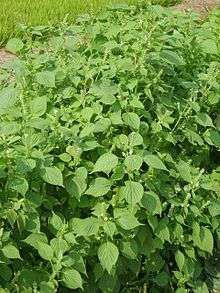 | |
| perilla growing in Gimpo | |
| Scientific classification | |
| Kingdom: | Plantae |
| Clade: | Tracheophytes |
| Clade: | Angiosperms |
| Clade: | Eudicots |
| Clade: | Asterids |
| Order: | Lamiales |
| Family: | Lamiaceae |
| Genus: | Perilla |
| Species: | P. frutescens |
| Binomial name | |
| Perilla frutescens | |
| Synonyms[1] | |
| |
Names
Along with other plants in the genus Perilla, the plant is commonly called "perilla". It is also referred to as "Korean perilla", due to its extensive cultivation in Korea and use in Korean cuisine. In Korean, the name kkae (깨) refers to both the plant and the seed of sesame and perilla.[7] Sesame is called chamkkae (참깨; literally "true kkae"), while perilla is called deulkkae (들깨; literally "wild kkae"). Because of this, deulkkae is sometimes mistranslated as "wild sesame". It is called egoma (荏胡麻) in Japanese, and, in Chinese, the plant is called zĭsū (紫苏) or sūzǐ (苏子).
The leaves are called "perilla", "perilla leaves", or "Korean perilla leaves" in English, and kkaennip (깻잎; literally "leaf of kkae") in Korean. The leaves are called sūyè (苏叶) or sūzǐyè (苏子叶) in Chinese.
In the USA, where the plant has become a weed, the plant is known by many names such as perilla mint, beefsteak plant, purple perilla, Chinese basil, wild basil, blueweed, Joseph's coat, wild coleus and rattlesnake weed.[6]
Infraspecific taxa
Perilla frutescens has three known varieties.[8]
- P. frutescens (var. frutescens) – called Korean perilla or deulkkae.
- P. frutescens var. crispa – also called shiso or tía tô.
- P. frutescens var. hirtella – also called lemon perilla.
Description
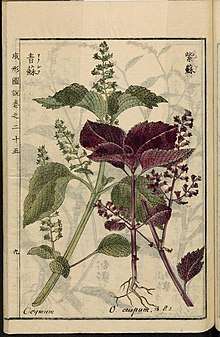
Perilla is an annual plant growing 60–90 centimetres (24–35 in) tall, with hairy square stalks.[9]
The leaves are opposite, 7–12 centimetres (2.8–4.7 in) long and 5–8 centimetres (2.0–3.1 in) wide, with a broad oval shape, pointy ends, serrated(saw-toothed) margins, and long leafstalks. The leaves are green with occasional touches of purple on the underside.[9]
The flowers bloom on racemes at the end of branches and the main stalk in late summer. The calyx, 3–4 millimetres (0.12–0.16 in) long, consist of upper three sepals and the hairy lower two. The corolla is 4–5 millimetres (0.16–0.20 in) long with its lower lip longer than the upper. Two of the four stamens are long.[9]
The fruit is a schizocarp, 2 millimetres (0.079 in) in diameter, and with reticulate pattern on the outside.[9] Perilla seeds can be soft or hard, being white, grey, brown, and dark brown in colour and globular in shape.[10][11] 1000 seeds weigh about 4 grams (0.14 oz).[11] Perilla seeds contain about 38-45% lipid.[12][13][14]



.jpg) ripe plants (autumn)
ripe plants (autumn)_seeds.jpg)
Cultivation
The plant was introduced into Korea before the Unified Silla era, when it started to be widely cultivated.[4]
In its natural state, the yield of perilla leaves and seeds is not high. If the stem is cut about 5 centimetres (2.0 in) above ground level in summer, a new stalk grows and it produces more fruit. Leaves can be harvested from the stem cut off in the summer, as well as from the new stalk and its branches, throughout summer and autumn. The seeds are harvested in autumn when the fruits are ripe. To collect perilla seeds, the whole plant is harvested and the seeds are beat out of the plant, before being spread for sun drying.
Traditional medicine, phytochemicals, and toxicity
Various perilla varieties are used for traditional medicine in Southeast Asia.[5] Leaves of P. frutescens var. crispa are more often used than var. frutescens in China for the supposed medicinal properties.
Characteristic aroma-active phytochemicals in perilla leaves include hydrocarbons, alcohols, aldehydes, furans, and ketones, particularly perilla ketone, egoma ketone, and isoegoma ketone.[5][2] Other compounds include perillaldehyde, limonene, linalool, beta-caryophyllene, menthol, and alpha-pinene.[5] The crispa variety is differentiated by leaf and stem colors, which vary from green to red to purple, indicating the presence of anthocyanins.[5][6]
Although perilla is widely cultivated as an edible plant for humans, it is toxic to cattle and other ruminants, as well as horses.[5] In grazing cattle, plant ketones cause acute respiratory distress syndrome,[5] also called "panting disease".[6]
Adverse effects
Contact dermatitis may occur in people handling the leaves or oil.[5] Consumption of large amounts of seeds has resulted in anaphylaxis.[5]
Nutritional value
Perilla seeds are rich in dietary fiber and dietary minerals such as calcium, iron, niacin, protein, and thiamine.[15] Perilla leaves are also rich in vitamins A, C and riboflavin.[15]
Use
Culinary
East Asia
China
In Manchu cuisine, perilla leaves are used to make efen, ("steamed bun").[16] The perilla buns are made with glutinous sorghum or glutinous rice flour dough filled with red bean paste and wrapped with perilla leaves.[16] The dish is related to Food Extermination Day, a traditional Manchu holiday celebrated on every 26th day of the 8th month of the lunar calendar.
Japan
In Japan, the plant is called egoma (荏胡麻), and used far less compared to shiso (Perilla frutescens var. crispa). In the Tōhoku regions of northwestern Japan, it is known as jūnen ("ten years"), because it was believed to add ten years to a person's lifespan. A local preparation in Fukushima Prefecture, called shingorō, consists of half-pounded non-glutinous rice patties, which are skewered, smeared with miso, blended with roasted and ground jūnen seeds, and roasted over charcoal.
Oil pressed from the seeds was historically used to in lamps. The warlord Saitō Dōsan (1494–1556) was said to have been originally a seller of egoma seed oil.
Korea
In Korean cuisine, kkaennip or perilla leaves are widely used as a herb and a vegetable. Kkaennip can be used fresh as a ssam vegetable, fresh or blanched as a namul vegetable, or pickled in soy sauce or soybean paste to make jangajji (pickle) or kimchi.
Deulkkae, the perilla seeds, are either toasted and ground into powder called deulkkae-garu or toasted and pressed to make perilla oil. Toasted deulkkae powder is used as a spice and a condiment for guk (soup), namul (seasoned vegetable dishes), guksu (noodle dishes), kimchi, and eomuk (fishcake). It is also used as gomul (coating or topping) for desserts: Yeot and several tteok (rice cake) varieties can be coated with toasted perilla powder. Perilla oil made from toasted perilla seeds is used as a cooking oil and as a condiment.
In Korean-style western food, perilla leaves are sometimes used to substitute basil, and the seed powder and oil is used in salad dressings as well as in dipping sauces. A Michelin-starred restaurant in Seoul serves nutty vanilla ice cream whose secret ingredient is perilla oil.[17]
 Kkaennip (perilla leaves) as a ssam (wrap) vegetable
Kkaennip (perilla leaves) as a ssam (wrap) vegetable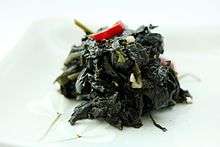 Kkaennip stir-fried in perilla oil
Kkaennip stir-fried in perilla oil.jpg) Kkaennip-jeon (pan-fried perilla leaves)
Kkaennip-jeon (pan-fried perilla leaves)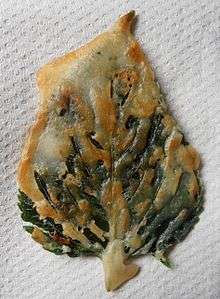 Kkaennip-bugak (deep-fried perilla leaves)
Kkaennip-bugak (deep-fried perilla leaves) Kkaennip-jangajji (pickled perilla leaves)
Kkaennip-jangajji (pickled perilla leaves) Kkaennip-kimchi (perilla leaf kimchi)
Kkaennip-kimchi (perilla leaf kimchi).jpg) Deulkkae (perilla seeds)
Deulkkae (perilla seeds)_deulkkae_(Perilla_frutescens)_buchu_(Allium_tuberosum).jpg) Chueo-tang (loach soup) served with chopi and deulkkae (perilla seed) powder
Chueo-tang (loach soup) served with chopi and deulkkae (perilla seed) powder Gamja-ongsimi (potato dough soup) boiled with deulkkae powder
Gamja-ongsimi (potato dough soup) boiled with deulkkae powder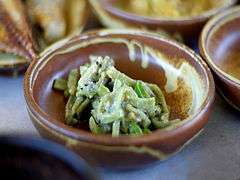 Goguma-sun-deulkkae-muchim (sweet potato stems seasoned with deulkkae powder)
Goguma-sun-deulkkae-muchim (sweet potato stems seasoned with deulkkae powder) Perilla granita
Perilla granita
South Asia
India
In India, perilla is called silam. Perilla seeds are roasted and ground with salt, chilis, and tomatoes to make a savoury side dish or chutney. In Kumaon the seeds of Bhangira (cultivated Perilla) are eaten raw, the seed oil is used for cooking purposes, and the oil cake is consumed raw or fed to cattle. The roasted seeds are also ground to prepare a spicy chutney. The seeds and leaves of Perilla are also used for flavoring curries. Manipuri cuisine uses the ground roasted seed in a salad locally known as 'singju'.
Nepal
In Nepal, perilla is called silam (सिलाम). Perilla seeds are roasted and ground with salt, chilis, and tomatoes to make a savoury dip/side dish or chutney.
Seed oil
Having a distinctive nutty aroma and taste, the oil pressed from the toasted perilla seeds is used as a flavor enhancer, condiment, and a cooking oil in Korean cuisine. The press cake remaining after pressing perilla oil can be used as natural fertilizer or animal feed.[18]
References
- "Perilla frutescens (L.) Britton". World Checklist of Selected Plant Families (WCSP). Royal Botanic Gardens, Kew – via The Plant List.
- Seo, Won Ho; Baek, Hyung Hee (2009). "Characteristic Aroma-Active Compounds of Korean Perilla (Perilla frutescens Britton) Leaf". Journal of Agricultural and Food Chemistry. 57 (24): 11537–11542. doi:10.1021/jf902669d. PMID 20000853.
- Acton, Q. Ashton, ed. (2012). Advances in Lamiaceae Research and Application. Atlanta, GA: ScholarlyEditions. ISBN 978-1-481-63590-5.
- 신, 현철. "deulkkae" 들깨. Encyclopædia Britannica (in Korean). Retrieved 30 November 2016.
- "Perilla". Drugs.com. 2018. Retrieved 15 February 2019.
- Steckel, Larry (2006). Perilla Mint (PDF). Extension PB 135. University of Tennessee Institute of Agriculture.
- "kkae" 깨. Standard Korean Language Dictionary (in Korean). National Institute of Korean Language. Retrieved 29 November 2016.
- "Perilla frutescens". Germplasm Resources Information Network (GRIN). Agricultural Research Service (ARS), United States Department of Agriculture (USDA).
- "deulkkae" 들깨. Korea Biodiversity Information System (in Korean). Korea National Arboretum. Retrieved 30 November 2016.
- Lee, Ju Kyong; Ohnishi, Ohmi (2001). "Geographic Differentiation of Morphological Characters among Perilla Crops and Their Weedy Types in East Asia". Breeding Science. 51 (4): 247–255. doi:10.1270/jsbbs.51.247.
- Asif, Mohammad (2011). "Health effects of omega-3,6,9 fatty acids: Perilla frutescens is a good example of plant oils". Oriental Pharmacy & Experimental Medicine. 11 (1): 51–59. doi:10.1007/s13596-011-0002-x. PMC 3167467. PMID 21909287.
- Shin, Hyo-Sun (1997). "Lipid Composition and Nutritional and Physiological Roles of Perilla Seed and its Oil". In Yu, He-ci; Kosuna, Kenichi; Haga, Megumi (eds.). Perilla: The Genus Perilla. London: CRC Press. p. 93. ISBN 9789057021718.
- Sonntag, N. O. V. (1979). "Fat splitting". Journal of the American Oil Chemists' Society. 56 (11): 729A–732A. doi:10.1007/BF02667430.
- Vaughan, John G. (1970). The Structure and Utilization of Oil Seeds. London: Chapman and Hall. pp. 120–121. ISBN 9780412097904.
- Duke, Jim; Duke, Peggy (1978). "Tempest in the Teapot: Mints". Quarterly Journal of Crude Drug Research. 16 (2): 71–95. doi:10.3109/13880207809083254.
- 东北满族在线 (18 July 2008). "图说满洲饽饽——苏子叶(粘耗子)制作过程 (图)". Boxun (in Chinese). Retrieved 5 May 2017.
- 글 쓰는 가지 (30 November 2016). "요리사는 예술을 내놓고 식객은 충격에 휩싸인다". Maeil Business Newspaper (in Korean). Retrieved 5 December 2016.
- "deulkkaenmuk" 들깻묵. Standard Korean Language Dictionary (in Korean). National Institute of Korean Language. Retrieved 6 December 2016.
| Wikimedia Commons has media related to Perilla frutescens. |
| Wikispecies has information related to Perilla frutescens |